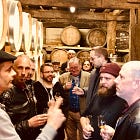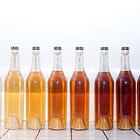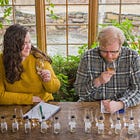Channeling My Inner Artie Bucco
Inspired by the world's oldest brandy, I went deep on an Armagnac pilgrimage.
Google Maps wasn’t wrong. But it wasn’t totally correct, either. We’d left the paved back roads of Ténarèze, in Armagnac, somewhere south of a town called Condom (yes, you read that right: Condom). Traveling along a gravel road through the vineyards, we could see our destination, the 17th century Domaine d’Aurensan, in the distance. But the gravel road quickly turned to grass, deeper into the vineyards. As I drove closer, my friends Adam and Kelly nervously watched as the grass got higher and path muddier, and then suddenly we followed a curve and stopped directly on the lawn of the chateau. When the owner of Domaine d’Aurensan, Bernard Rozès, came outside to meet us, he had quite a laugh to find us parked in his front yard.
A little minor travail on the road did not seem out of line. For me, this was very much a pilgrimage to visit the Rozès family—which owns both Domaine d’Aurensan and Château de Léberon. A few years prior I had published a tasting report in which I rated around a hundred Armagnacs, and both estates’ exquisite brandies earned my top scores. I had given Château de Léberon’s 1987 vintage a rating of 99 points, and described it so:
This is a philosopher’s Armagnac, at 29 years old, the color of dark topaz that keeps unfolding and unfolding in the glass. At first, there are bright and youthful aromas of candied ginger and orange zest, then things turn savory and complex, with cardamom, fallen leaves, campfire, and even a hint of cannabis. On the palate, there’s gingerbread, then deep earth, with notes of sweet smoke. The finish is long and almost emotional. What’s evoked here is the youthfulness and zest gently gilding past toward decaying autumn leaves, suggesting the last bonfire of the year. My clear favorite of the entire tasting.
Ok, yes: I can get a little carried away with the tasting notes. Still, there was something more than “almost” emotional about these spirits. In fact, of all the spirits in the world, Armagnac may deliver more of these transcendent moments than any other.
Domaine d’Aurensan, with only 7 hectares of vines, ages its brandies in casks made from oak trees grown on its estate. Château de Léberon, with 14 hectares of 40- to 60-year old vines, only bottles at cask strength and releases no Armagnac younger than 20 years old. Both estates follow a “triple zero” philosophy: zero water, zero sugar, zero coloring.
Rozès walked us through his vineyards of ugni blanc, folle blanche, colombard, and baco—the typical grapes of Armagnac. But he also pointed out the rows of “ghost grapes,” where they grow the six grapes originally planted before phylloxera in the 19th century, including plant de graisse, mauzac (blanc and rosé), and Jurançon blanc. The vines are still young, but they make a fresh, delicious young Armagnac with those ghost grapes called Le Carré des Fantômes.
“We are just a little producer,” said Rozès. “We don’t buy or sell from anyone else.” In Armagnac, this is both a modest and loaded statement. As spirits aficionados, we often get caught up in ages, in numbers, in barrels. But Armagnac (just like Cognac) begins life as grapes in a vineyard, pressed and fermented into wine, then distilled. There is always a grower and a winemaker at the root of the equation.
“It’s not for nothing that we strive to make a fantastic vinification,” says Claire de Montesquiou, who owns the 45-hectare Domaine d’Espérance estate in Bas-Armagnac. “If not, it’s like cooking with a bad chicken. It doesn’t matter how well you cook a bad chicken.”
Brandy lovers know this, but often it becomes an abstraction. We love the allure of drinking from decades-old barrels that a négociant—a treasure hunter—has discovered and procured from an elderly grower, or a widow. But those barrels often represent the end of a multi-generational wine-growing family. The numbers don’t lie: In 50 years, the total vineyard area of Armagnac has shrunk from 10,000 to 2,000 hectares. “This tradition is dying,” says Lili de Montal, at Château Arton, with around 40 hectares in Haut-Armagnac. “It’s not an overstatement to say it’s a disaster.”
These days in Armagnac, there’s an uneasy relationship between grower-producers and négociants who blend and bottle barrels that they acquire from others.
Before our visit with Rozès, Adam, Kelly, and I had spent a delightful day and evening with L’Encantada, celebrating their 10th anniversary. L’Encantada is the new-wave négociant whose barrel selections are now coveted by spirits aficionados around the world. L’Encantada bottlings from estates such as Lous Pibous, Le Frêche, and Del Cassou are the darlings of social media and a brandy market that’s beginning to steal thunder from bourbon. L’Encantada follows in the footsteps of famed Armagnac négociants such as Darroze, who always faithfully share, on the label, whichever domain they acquired the barrels from. It was hard to beat the excitement of tasting at L’Encantada with other brandy geeks from Europe and the US.
But even the team at L’Encantada seems to sense that endless barrel picking is not sustainable. As part of the festivities, they took us to see the vineyard they’d recently planted in Bas Armagnac, from which they now intend to produce and distill their own juice. Good news that this kind of reckoning with the land is happening.
Later, at Domaine d’Aurensan, Rozès poured us through the Domaine d’Aurensan line—blends of 15, 20, and 30 years old and vintages from 2001 (20 years old), 1998 (24 years old), and 1979 (40 years old). One after another, they showed why I’m often drawn to Ténarèze over Bas-Armagnac. Even at younger ages, the fruit takes a step back, and complex aromas of antique varnish, cedar, brown butter, hazelnut, exotic spices, and tobacco appear. And always, there’s this underlying clay minerality.
But Rozès wasn’t finished with us. We moved our car off his lawn, and followed him a few kilometers down the road to Château de Léberon. He opened the gate and told us this estate dated to the 14th century. His grandfather had bought the property in 1939. “The castle had been uninhabited since the French Revolution,” he said.
We made our way into his dark cellar, covered in the tell-tale black mold of the “angel’s share.” We tasted several vintages, including my beloved 1987 — which was topped on this day by the 1998, 1994, 1988, and 1984. But then we tasted the 1964, one I had sampled several years ago. Here were my notes then:
At 51 years old, it’s incredible how much life the 1964 still has. Concentrated and nut brown in color, with mature aromas of perfume, antique varnish, and dried fig. Yet in the mouth, it’s more about feelings than flavors, expansive with soft, supple minerality. It’s big, but there’s a delicate elegance to it. The rancio is so pronounced it suggests an entire lifetime, which is how long the finish feels.
And now, tasting it on this day, in the cellar of Château de Léberon, the whole experience was even deeper. This was not a spirit meant to be turned into to some whiskey-like brown liquid. This was something akin to a religious experience. Our voices, which had been hyper and loud all day, grew quieter. Adam and I gathered all the cash we had in our wallets and bought two bottles, the 1988 and 1964, which Rozès labeled by hand. It felt like an offering.
Among my friends who proselytize about Armagnac, we often joke that we feel like Artie Bucco, Tony’s restaurateur pal in The Sopranos, who infamously gets suckered into a bad business deal to import Armagnac, borrowing money from Tony on the pitch that it’s “the next vodka.” Things didn’t go so well for Artie Bucco.
Armagnac—brandy in general—isn’t going to be the next vodka. It might not even be “the new bourbon.” That, I hope we all realize, is a fine thing.









Lol: "somewhere south of a town called Condom."
Armagnac, from what I've read here (and in other Everyday Drinking articles) seems to be the antithesis of the tequila craze, the "gin-aissance" and the vodka madness of the 2020s.
In our contemporary world it seems that often brands and influencers trump quality in most cases. Even Cognac is basically understood by most people to be about the 4 big brands.
It is great to read articles such as this, but it is also bittersweet; as for most people, unless you go to Armagnac and get lost in the grass it's highly unlikely you will ever get to have this amazing experience. Cheers!